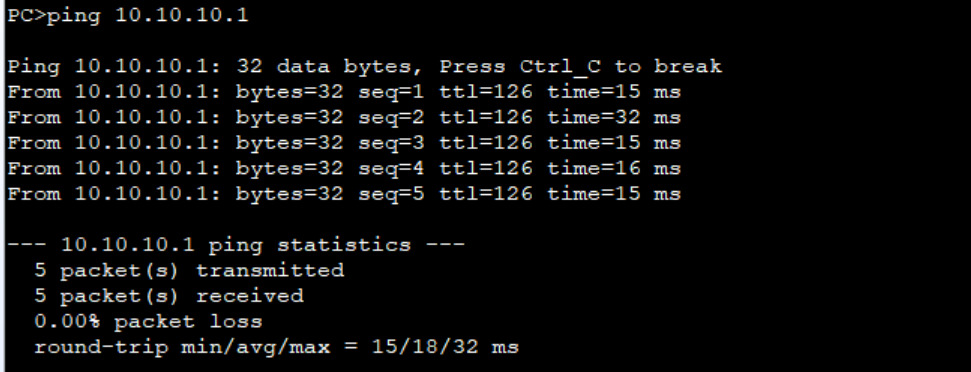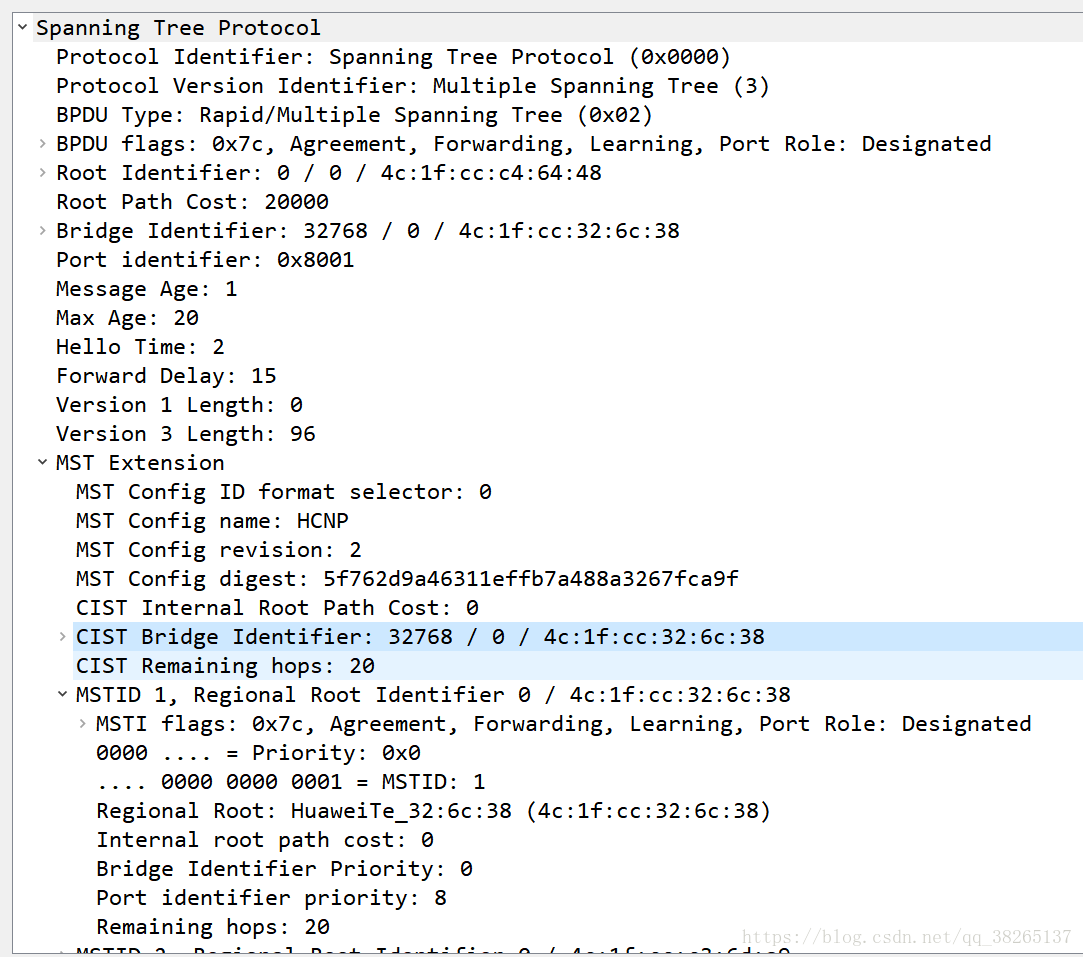1.vlan
[SW1]vlan batch 10 20 30 //一次性划分多个VLAN [SW1-Ethernet0/0/1]port link-type access //接口改成ACCESS模式 [SW1-Ethernet0/0/1]port default vlan 10 //接口划分进vlan10 [SW2-GigabitEthernet0/0/1]port link-type trunk //接口改成trunk模式 [SW2-GigabitEthernet0/0/1]port trunk allow-pass vlan 10 20 //trunk模式下放通vlan10和20 [SW2]vlan 10 [SW2-vlan10]description Technical //给vlan一个备注 [SW1]interface Vlanif 10 [SW1-Vlanif10]ip add 192.168.1.1 24 //进入vlan给它一个地址,可以用于与路由器通信,或者作为终端的网关,也可以在vlanif内配置DHCP
2.stp
[SW1]stp enable //开启生成树,(华为默认开启,多生成树)
[SW1]stp mode {stp | rstp | mstp} //切换生成树模式
[SW1]stp priority 0 //更改生成树优先级,默认32768
[SW1]undo stp priority //删除配置的优先级
[SW1]stp root primary //设置本交换机为根桥 交换机
[SW2]stp root secondary //设置本交换机为备份根桥 从交换机
2.ospf
(优先从Loopback地址中选择最大的IP地址作为Router-ID。如果没有配置Loopback接口,则在接口地址中选取最大的IP地址作为Router-ID。)
[R1]ospf 1 router-id 1.1.1.1 //创建一个OSPF进程,进程号为1,ospf的routerid为1.1.1.1
[R1-ospf-1]import-route {direct | static | ospf} //引入 {直连 | 静态 | OSPF外部} 路由 ,非中级内容不做介绍
[Huawei-ospf-1]default-route-advertise //引入默认路由,加上always 则下发一条默认路由
[R1-ospf-1]area 0 //进入区域0
[R1-ospf-1-area-0.0.0.0]network 192.168.1.0 0.0.0.255 //宣告网段。IP地址段后面是反掩码
[R1-ospf-1-area-0.0.0.0]authentication-mode md5 1 cipher 123456 //设置区域认证为MD5 密码是12346
[R1-ospf-1-area-0.0.0.0]authentication-mode simple cipher 123456 //设置区域认证为简单模式 密码12346
//plain为明文认证
display ip routing-table protocol ospf //查看OSPF路由表
display ospf peer brief //查看OSPF邻居状态
3.静态路由
[R2]ip route-static 10.10.10.0 24 40.40.40.1 //去往10.10.10.0的网段 掩码为24 下一跳地址为40.40.40.1 [R2]ip route-static 10.10.10.0 24 serial1/0/1 //去往10.10.10.0的网段 掩码为24 下一跳地址为自己的出接口 [R1]ip route-static 0.0.0.0 0.0.0.0 10.10.10.10 //默认路由是特殊的静态路由,路由表没有记录的网段都可以去往10.10.10.10 [R1]ip route-static 0.0.0.0 0.0.0.0 20.20.20.10 preference 100 //配置本条静态路由优先级为100,一般用于配置浮动路由
4.单臂路由
[R1]interface GigabitEthernet 0/0/0.1 //进入子接口 [R1-GigabitEthernet0/0/0.1]dot1q termination vid 10 //终结含多层VLAN的数据包的最外层标签 [R1-GigabitEthernet0/0/0.1]ip address 192.168.1.254 24 //配置地址 [R1-GigabitEthernet0/0/0.1]arp broadcast enable //开启ARP广播
缺省情况下,终结子接口没有使能ARP广播功能。
如果终结子接口上没有配置arp broadcast enable命令,那么系统会直接把该IP报文丢弃。此时该终结子接口的路由可以看作是黑洞路由。
如果终结子接口上配置了arp broadcast enable命令,那么系统会构造带Tag的ARP广播报文,然后再从该终结子接口发出。
5.VRRP
[R1-GigabitEthernet0/0/0]vrrp vrid 1 virtual-ip 192.168.1.254 //在接口模式下配置VRRP VRID为1 虚拟地址为192.168.1.254 [R1-GigabitEthernet0/0/0]vrrp vrid 1 priority 150 //设置VRID为1的VRRP组优先级为150,默认值为100,取值范围1-254 [R1-GigabitEthernet0/0/0]vrrp vrid 1 authentication-mode md5 123456 //设置VRRP的认证 仅支持MD5与simple [R1-GigabitEthernet0/0/0]vrrp vrid 1 track interface GigabitEthernet0/0/1 reduced 20 //VRRP组1要监控GE0/0/1口,如果该接口的协议状态或者是物理状态变成DOWN,则将该VRRP组的优先级减去20
6.链路聚合
[SW1]int Eth-Trunk 1 //进入或创建聚合组 [SW1-Eth-Trunk1]trunkport GigabitEthernet 0/0/1 to 0/0/3 //添加g0/0/1到g0/0/3及之间的接口到聚合内,不加 to 就是间断添加接口 [SW1-Eth-Trunk1]port link-type trunk //改变聚合组链路类型为trunk,与在交换机接口内改链路类型类似,其他端口特性不列举 [SW1-Eth-Trunk1]mode lacp-static //更改聚合模式为静态LACP,缺省的工作模式为手工负载分担模式 [SW1-GigabitEthernet0/0/1]lacp priority 1000 //配置接口优先级,缺省值32768
7.pap认证
配置本端PPP协议的认证方式为PAP。需要先执行aaa命令
[R1]aaa //进入aaa视图 [R1-aaa]local-user huawei password cipher 123456 //创建用户名为huawei 加密类型为密文 密码为123456的账户 [R1-aaa]local-user huawei service-type ppp //设置huawei账户的用于ppp服务 [R1-aaa]int s4/0/0 [R1-Serial4/0/0]link-protocol ppp //设置接口在L2层封装PPP协议 [R1-Serial4/0/0]ppp authentication-mode pap //在主认证端上指明ppp的认证方式为pap display ip interface brief //查看接口状态
对端配置(被认证端)
[R2]int s4/0/0 [R2-Serial4/0/0]link-protocol ppp //设置接口在L2层封装PPP协议 [R2-Serial4/0/0]ppp pap local-user huawei password cipher 123456 //设置用于认证的账户与密码
8.chap认证
配置本端PPP协议的认证方式为chap。需要先执行aaa命令
[R1]aaa //进入aaa视图 [R1-aaa]local-user huawei password cipher 123456 //创建用户名为huawei 加密类型为密文 密码为123456的账户 [R1-aaa]local-user huawei service-type ppp //设置huawei账户的用于ppp服务 [R1]interface Serial 4/0/0 [R1-Serial4/0/0]link-protocol ppp //设置接口在L2层封装PPP协议 [R1-Serial4/0/0]ppp authentication-mode chap //在主认证端上指明ppp的认证方式为chap display ip interface brief //查看接口状态
对端配置(被认证端)
[R2]int s4/0/0 [R2-Serial4/0/0]link-protocol ppp //设置接口在L2层封装PPP协议 [R2-Serial4/0/0]ppp chap user huawei //设置用于认证的账户 [R2-Serial4/0/0]ppp chap password cipher 123456 //设置用于认证的密码
9.PPPoE认证
配置 PPPoE 地址池,通过使用全局地址池给对端分配地址,实现 PPPoE Server 为 PPPoE Client动态分配IP地址
[ISP]ip pool pppoe [ISP-ip-pool-pppoe]gateway-list 20.20.20.1 [ISP-ip-pool-pppoe]network 20.20.20.0 mask 255.255.255.0
配置PPPoE认证端
[ISP]aaa //进入AAA视图 [ISP-aaa]local-user huawei password cipher 123456 //创建用户名为huawei 加密类型为密文 密码为123456的账户 [ISP-aaa]local-user huawei privilege level 0 //设置账户权限等级 [ISP-aaa]local-user huawei service-type ppp //设置huawei账户的用于ppp服务 [ISP]interface Virtual-Template 1 //进入虚拟接口模板VT [ISP-Virtual-Template1]ppp authentication-mode chap //在主认证端上指明ppp的认证方式为chap [ISP-Virtual-Template1]remote address pool pppoe //本端PPPoE协议对对端设备的认证方式为CHAP [ISP-Virtual-Template1]ip address 20.20.20.1 255.255.255.0 //配置虚拟接口地址 [ISP]interface GigabitEthernet 0/0/0 [ISP-GigabitEthernet0/0/0]pppoe-server bind Virtual-Template 1 //在以太网接口G0/0/0上启用PPPoE Server功能
配置 PPPoE 客户端
[R1]interface Dialer1 //用于该设置作为PPPOE客户端的拨号使用 [R1-Dialer0]ppp chap user huawei //账户为huawei [R1-Dialer0]ppp chap password cipher 123456 //加密方式为密文 密码为123456 [R1-Dialer0]tcp adjust-mss 1200 //MSS,TCP分片设置为1200 MTU=MSS+TCP Header+IP Header [R1-Dialer0]ip address ppp-negotiate //地址的获取方式从对端服务器得到 [R1-Dialer0]dialer user huawei //用来配置PPP chap认证里面的用户名 [R1-Dialer0]dialer bundle 1 //指定Dialer接口使用的Dialer bundle。设备通过Dialer bundle将物理接口与拨号接口关联起来。 [R1]interface GigabitEthernet0/0/0 // [R1-GigabitEthernet0/0/0] pppoe-client dial-bundle-number 1 //实现Dialer Bundle和物理接口的绑定,用来指定PPPoE会话对应的Dialer Bundle [R1] ip route-static 0.0.0.0 0 dialer 1 //配置缺省路由
10.端口安全
在交换机端口上打开端口安全功能,将MAC地址绑定到相对应接口中,并在vlan1上有效。(注意:PC的MAC地址需要四位一敲)
[SW1]interface Eth0/0/1 [SW1-Etherneto/0/1]port-security enable [SW1-Etherneto/0/1]port-security mac-address sticky [SW1-Etherneto/0/1]port-security mac-address sticky 5489-9890-1CA8 vlan 1 [SW1]interface Eth0/0/2 [SW1-Etherneto/0/2]port-security enable [SW1-Etherneto/0/2]port-security mac-address sticky [SW1-Etherneto/0/2]port-security mac-address sticky 5489-98B4-144E vlan 1 [SW1]interface Eth0/0/3 [SW1-Etherneto/0/3]port-security enable [SW1-Etherneto/0/3]port-security mac-address sticky [SW1-Etherneto/0/3]port-security mac-address sticky 5489-9837-5862 vlan 1 [SW1-Etherneto/0/3]quit
在交换机上使用display mac-address命令,查看交换机与计算机之间连接的端口,类型是否变为sticky。
11.基本ACL
[SW1]acl 2000//进入基本ACL 2000 [SW1-acl-basic-2000]rule permit source 192.168.30.0 0.0.0.255 //允许数据包源网段为 192.168.30.0 的报文通过 [SW1-acl-basic-2000]rule deny //华为未命中的默认运许,所与写一个拒绝所有 [SW1]int G0/0/2 [SW1-GigabitEthernet0/0/2]traffic-filter outbound acl 2000 //将规则应用到 G0/0/2 的端口出方向上 [SW1-GigabitEthernet0/0/2]quit [SW1-acl-basic-2001]rule deny source 192.168.40.0 0.0.0.255 //拒绝数据包源网段为 192.168.40.0 的报文通过
12.高级ACL
[R1]acl 3000 //进入高级ACL 3000 [R1-acl-adv-3000]rule 5 permit tcp source 192.168.10.1 0 destination-port eq 80 //允许财务部 PC1 对服务器 80 端口的访问 [R1-acl-adv-3000]rule 10 deny ip //拒绝所有IP [R1]int G0/0/1 [R1-GigabitEthernet0/0/1]traffic-filter outbound acl 3000 //应用到 G0/0/1 的端口出方向上 [R1-GigabitEthernet0/0/1]quit
13.Easy IP
使用Easy IP前需要创建ACL来建立规则,如
[R1]acl 2000 [R1-acl-basic-2000]rule permit source 192.168.10.0 0.0.0.255 [R1-acl-basic-2000]int G0/0/1 [R1-GigabitEthernet0/0/1]nat outbound 2000 //在G0/0/1接口下使用nat outbound命令配置Easy-IP特性,直接使用接口IP地址作为NAT转换后的地址。
14.静态NAPT
在R1的G0/0/1接口上,使用nat server命令定义内部服务器的映射表,指定服务器通信协议为TCP,配置服务器使用的互联网IP为16.16.16.1,服务器内网为192.168.1.1,指定端口号为80。 [R1]interface GigabitEthernet 0/0/1 [R1-GigabitEthernet0/0/1]nat server protocol tcp global 16.16.16.1 80 inside 192.168.1.1 80
15.动态NAT
[R1]nat address-group 1 16.16.16.1 16.16.16.5 //令配置 NAT 地址池
创建基本ACL建立规则
[R1]acl 2000 [R1-acl-basic-2000]rule permit source 192.168.10.0 0.0.0.255
[R1-acl-basic-2000]int G0/0/1 [R1-GigabitEthernet0/0/1]nat outbound 2000 address-group 1 no-pat //命令将ACL2000与地址池相关联,使得ACL中规定的地址可以使用地址池进行地址转换
16.静态NAT
[R1]interface GigabitEthernet 0/0/1 [R1-GigabitEthernet0/0/1]nat static global 16.16.16.1 inside 192.168.1.1 //命令配置内部地址到外部地址一对一转换
17.IPV6
[R1]ipv6 //全局下开启IPV6 [R1]interface GigabitEthernet 0/0/0 [R1-GigabitEthernet0/0/0]ipv6 enable //接口下开启IPV6 [R1-GigabitEthernet0/0/0]ipv6 address 2010::1/64 //配置IPV6地址

我的微信
微信号已复制
我的微信
这是我的微信扫一扫





